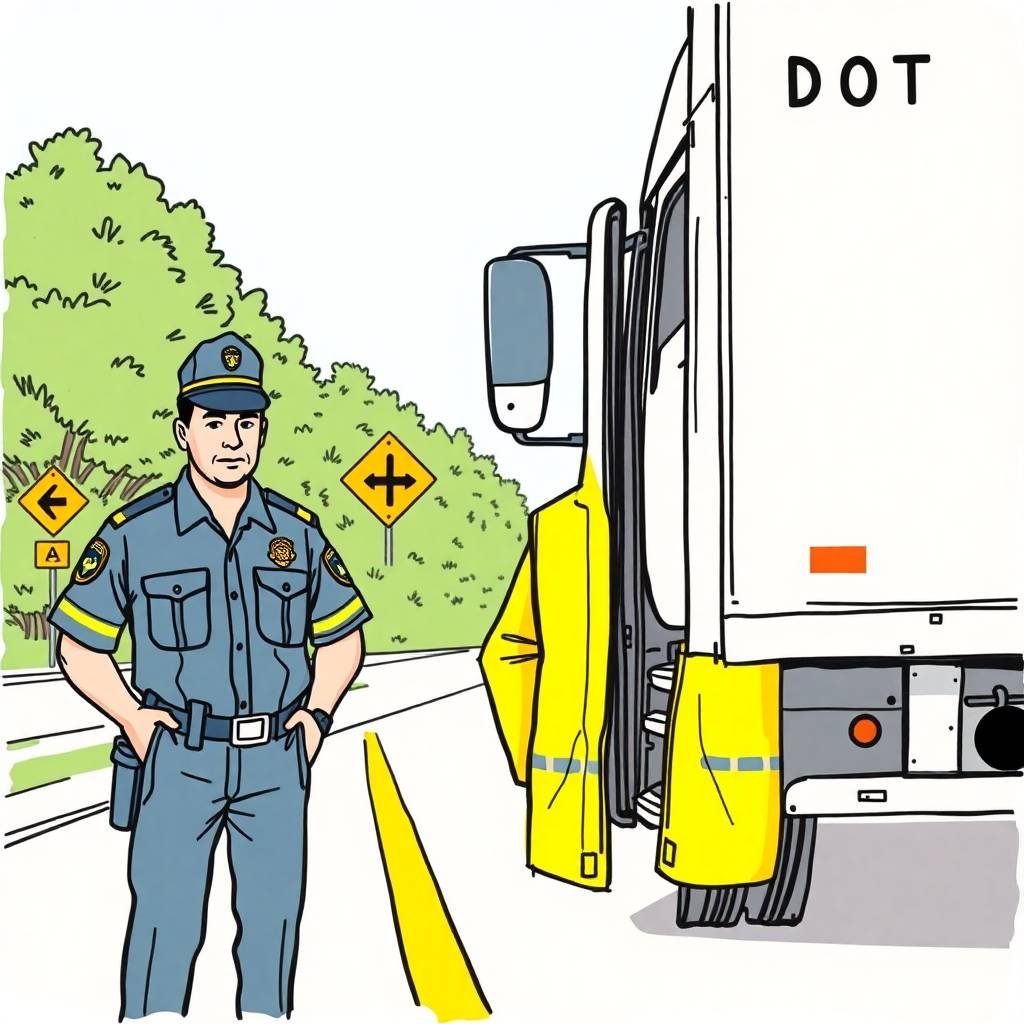1. Understanding HOS Rules for Drivers: Why They Matter More Than Ever
In today’s fast-paced freight industry, Understanding HOS Rules for Drivers has become more critical than ever before. Hours of Service (HOS) regulations are designed by the Federal Motor Carrier Safety Administration (FMCSA) to prevent fatigue-related accidents, protect public safety, and ensure driver well-being. As the industry evolves and compliance standards tighten, knowing how to navigate these rules isn’t just important—it’s essential for survival in the trucking business.
What Are HOS Rules?
HOS rules set the maximum number of daily and weekly hours commercial motor vehicle (CMV) drivers are allowed to be on duty, including drive time and rest periods. Staying compliant helps you avoid violations that can lead to penalties, audits, or worse—accidents. The FMCSA website provides the most current regulations, which should be reviewed regularly.
For carriers, Understanding HOS Rules for Drivers includes staying updated with driver qualification file requirements, logging practices, and managing fatigue-related risks effectively. Learn more in our driver qualification file monitoring guide.
Why Compliance Matters Now More Than Ever
Failing to comply with HOS regulations can put your operation at risk. A violation can trigger a DOT audit, affecting your FMCSA Safety Measurement System (SMS) score and potentially removing you from service. Our DOT compliance checklist can help you stay ahead of potential issues.
If you’re preparing for a DOT audit, explore our audit preparation services for proactive support.
Tools and Resources for Better Compliance
Staying compliant goes beyond just Understanding HOS Rules for Drivers. It includes managing a complete drug and alcohol testing program, DQ file setup, and UCR filing. We provide resources and services such as:
For common violations to avoid, read our post on FMCSA compliance mistakes.
How to Stay Ahead
Understanding HOS Rules for Drivers means integrating best practices into your operations. This includes regular checks of driver logs, using compliant ELDs, and conducting internal audits. Our team offers expert guidance on FMCSA compliance requirements and DQ file violations.
If you’re an owner-operator, see our compliance checklist tailored for you.
Get Personalized Help
Need help navigating these rules? Schedule your appointment with our compliance experts. For valuable insights, visit our blog and resource hub.
You can also explore related topics like FMCSA Clearinghouse compliance, DOT drug testing requirements, and random DOT drug testing.
Explore More
For additional resources:
We encourage all visitors to review our Disclaimer, Privacy Policy, and Terms of Service to understand your rights and responsibilities while using our site.
In conclusion, Understanding HOS Rules for Drivers isn’t just about avoiding penalties—it’s about running a safer, more efficient, and compliant operation. The stakes have never been higher, and the resources are readily available to support you.

2. The 11-Hour Driving Limit: What Every Fleet Operator Must Enforce
For fleet operators striving for compliance, safety, and operational efficiency, Understanding HOS Rules for Drivers is non-negotiable. One of the most critical components of these regulations is the 11-hour driving limit, a rule set by the Federal Motor Carrier Safety Administration (FMCSA) that governs how long a commercial driver can operate a vehicle after ten consecutive hours off duty. Enforcing this rule protects drivers, preserves your CSA score, and ensures that your company operates within legal boundaries.
What Is the 11-Hour Rule and Why Is It Important?
The 11-hour rule permits drivers to operate a CMV for up to 11 hours following at least 10 hours of consecutive off-duty time. It exists to reduce fatigue and the risks associated with extended periods of driving. For fleet managers, Understanding HOS Rules for Drivers begins with strictly enforcing this rule through proper training, monitoring, and log audits.
To remain fully compliant, ensure your team reviews the latest information on Transportation.gov and utilizes our comprehensive DOT Compliance Checklist.
HOS Enforcement and Safety Culture
Beyond ticking boxes, enforcing HOS rules reflects a company’s commitment to safety. Fleet operators must invest in driver qualification file requirements, regularly monitor logs, and ensure that each driver understands when to rest and when they are legally allowed to operate. Access our DQ file setup and monitoring services to streamline this process.
Our detailed breakdown on FMCSA Safety Measurement System (SMS) shows how HOS compliance directly impacts your safety score.
Understanding HOS Rules for Drivers Across All Compliance Areas
To stay compliant with HOS regulations and avoid FMCSA compliance mistakes, it’s vital to take a holistic approach. That means ensuring proper pre-employment DOT drug testing, random drug testing programs, and complete drug and alcohol testing compliance.
Supporting these processes with services like our DOT audit preparation and BOC-3 process agent compliance enhances readiness for inspections.
Resources and Services That Make Compliance Easier
Fleet operators navigating complex regulations can benefit from our FMCSA compliance services for owner-operators. Whether you need help with UCR filing or IFTA/IRP support, we offer tailored services to keep you compliant.
To stay informed on all areas of compliance, visit Truckers Compliance Hub to read the latest posts, including FMCSA Clearinghouse compliance and the Driver Drug and Alcohol Testing Program.
Why Act Now?
Understanding HOS Rules for Drivers isn’t just about avoiding penalties. It’s about reducing liability, boosting safety, and staying in business. If your fleet has yet to implement a clear strategy for enforcing the 11-hour rule, schedule your appointment today to get personalized support.
We also offer help for owner-operators and resources for improving overall FMCSA compliance.
Stay Informed and Protected
Explore more resources for trucking companies, including:
Before using our services, please review our Disclaimer, Privacy Policy, and Terms of Service.
In conclusion, Understanding HOS Rules for Drivers—especially the 11-hour driving limit—is essential for every fleet operator aiming to remain compliant, protect drivers, and thrive in today’s regulatory environment.

3. Decoding the 14-Hour Rule: Avoiding Scheduling Pitfalls
Fleet managers and drivers alike face a constant challenge: maximizing productivity without violating Hours of Service (HOS) regulations. Understanding HOS Rules for Drivers is key to avoiding costly scheduling pitfalls, particularly when it comes to the 14-hour rule—a rule that’s often misunderstood and frequently violated.
What Is the 14-Hour Rule?
The 14-hour rule limits drivers to a 14-hour window in which they may operate a commercial motor vehicle after coming on duty. Unlike the 11-hour driving limit, the 14-hour rule doesn’t pause for breaks or stops. Once the clock starts, it doesn’t stop. This underscores the importance of Understanding HOS Rules for Drivers when planning routes and assigning loads.
For a deeper dive into federal regulations, visit the FMCSA website or Transportation.gov. You can also stay updated by following our latest content on Truckers Compliance Hub.
Scheduling Pitfalls and Compliance Risks
The most common scheduling mistake is underestimating the impact of on-duty time. Delays at loading docks or prolonged fueling periods still count toward the 14-hour window. Failing to factor in these delays can result in violations. That’s why Understanding HOS Rules for Drivers must extend beyond just driving hours—it requires proactive planning.
Utilize our DOT Compliance Checklist and Driver Qualification File Requirements to ensure your drivers are not only compliant but well-informed.
Protecting Your Fleet From Violations
Violations of the 14-hour rule can increase your CSA score, triggering audits and enforcement actions. To safeguard your operation, review our guide on FMCSA Safety Measurement System (SMS) 2025. If you’re preparing for a review, our DOT Audit Preparation resources are an essential tool.
In addition, mismanagement of HOS rules can intersect with other compliance areas. We offer support with DQ File Setup and Monitoring, Drug and Alcohol Testing Management, and help you prevent FMCSA Compliance Mistakes.
Support Services to Simplify Compliance
Managing all of these elements takes time and expertise. That’s why we offer tailored solutions including:
- IFTA/IRP/BOC-3 Support
- UCR Filing Assistance and Deadlines, UCR Deadlines
- BOC-3 Process Agent Compliance
- DOT Compliance Checklist for Owner-Operators
If you’re ready to get serious about compliance, schedule your appointment now for a one-on-one session with a compliance expert.
Stay Informed and Empowered
To enhance your knowledge, explore:
We also cover essential topics like:
- FMCSA Clearinghouse Compliance
- Drug and Alcohol Testing Compliance
- Driver Drug and Alcohol Testing Program
Before using our services, please review our Disclaimer, Privacy Policy, and Terms of Service.
Conclusion
Understanding HOS Rules for Drivers—especially the 14-hour rule—is essential for effective scheduling and avoiding violations. Equip your fleet with knowledge, resources, and the support it needs to thrive in a highly regulated environment.

4. The 30-Minute Break Rule: Small Pause, Big Impact
In today’s fast-paced freight industry, efficiency and compliance go hand in hand. One of the most underestimated but crucial aspects of understanding HOS rules for drivers is the 30-minute break rule. While it may seem like a minor interruption in a busy schedule, this federally mandated pause plays a significant role in both safety and operational success.
What is the 30-Minute Break Rule?
Under Federal Motor Carrier Safety Administration (FMCSA) regulations, drivers must take a 30-minute break after eight cumulative hours of driving time. This break can be satisfied by any non-driving duty status, such as off-duty or sleeper berth. For full details on the regulation, refer to the official FMCSA website and Transportation.gov.
Understanding HOS rules for drivers requires grasping how this seemingly small pause contributes to reducing fatigue, enhancing road safety, and preventing violations that could impact a carrier’s safety score.
Why the 30-Minute Break Rule Matters
Too often, fleet operators overlook this rule in the name of tight delivery schedules. However, skipping this break can result in violations, audits, and an increase in CSA scores. Our FMCSA Safety Measurement System (SMS) 2025 guide explains the real impact of such infractions.
Staying compliant with the 30-minute rule is just one part of a broader framework. Understanding HOS rules for drivers also means managing documentation, training, and route planning accordingly.
For assistance with proactive compliance, we offer tools like the DOT Compliance Checklist and support with DOT Audit Preparation.
How to Integrate the Break into Your Operations
Effective HOS compliance begins with education. Equip your team with knowledge from our latest insights on Truckers Compliance Hub. Ensure your drivers’ Driver Qualification Files and DQ File Monitoring are updated, and review your processes for drug and alcohol testing compliance and FMCSA Clearinghouse requirements.
Understanding HOS rules for drivers means being proactive with pre-employment drug testing, random DOT drug testing, and ongoing driver testing programs.
Compliance Solutions that Fit Your Fleet
To streamline compliance, our services include:
- DOT Audit Preparation
- Drug and Alcohol Testing Management
- UCR Filing Assistance
- BOC-3 Process Agent Compliance
- IFTA/IRP/BOC-3 Support
Whether you’re an owner-operator or a large fleet, our FMCSA compliance services and checklist for owner-operators can help you stay on track.
Take the Next Step
Understanding HOS rules for drivers is a continuous effort. Schedule a 30-minute consultation to assess your compliance strategy. Explore more guidance and resources on FMCSA compliance help for trucking companies.
Before utilizing our services, review our Disclaimer, Privacy Policy, and Terms of Service.

5. Understanding HOS Rules for Drivers: The 60/70-Hour Rule Explained
When it comes to understanding HOS rules for drivers, one of the most misunderstood—and most critical—is the 60/70-hour rule. While daily driving limits like the 11-hour and 14-hour rules receive significant attention, the cumulative work hour limits over a 7- or 8-day period are equally vital for maintaining compliance, safety, and operational efficiency.
What Is the 60/70-Hour Rule?
The 60/70-hour rule is part of the Federal Motor Carrier Safety Administration (FMCSA) Hours of Service (HOS) regulations, which dictate how long commercial motor vehicle (CMV) drivers can legally operate. According to the FMCSA, a driver may not exceed:
- 60 hours in 7 consecutive days if the company does not operate vehicles every day of the week.
- 70 hours in 8 consecutive days if the company operates vehicles every day.
Drivers must then take a 34-hour restart break before resuming a new cycle. For deeper regulatory context, visit Transportation.gov.
Why Fleet Operators Must Pay Attention
Understanding HOS rules for drivers goes beyond compliance; it’s about risk management. Violating the 60/70-hour rule can result in out-of-service orders, penalties, and negative impacts on your FMCSA Safety Measurement System (SMS) scores.
Fleet managers can reduce risk by reviewing their operations with tools like the DOT Compliance Checklist and utilizing support services for DOT Audit Preparation.
How to Track and Enforce the Rule
Fleet compliance starts with accurate logs and driver awareness. The best strategy includes regular audits, automated log management systems, and updated Driver Qualification Files. If your drivers have had recent DQ file violations, now is the time to act.
We provide end-to-end services including DQ File Setup and Monitoring and drug and alcohol testing management, all key components of understanding HOS rules for drivers.
To ensure your operation runs smoothly, don’t overlook our support for UCR filing, IFTA filing requirements, and BOC-3 process agent compliance.
Avoiding Costly Compliance Mistakes
Many companies make common FMCSA compliance mistakes due to confusion around HOS tracking. For example, not aligning schedules with cumulative hour limits or failing to implement mandatory random DOT drug testing.
By focusing on understanding HOS rules for drivers, and using the right resources—including FMCSA Clearinghouse Compliance—you can reduce your audit risks and maintain a safe, productive fleet.
Take Action Today
If you’re unsure whether your operation is compliant with the 60/70-hour rule, it’s time to reassess. Schedule your free 30-minute consultation to get expert help.
Stay informed with the latest insights on Truckers Compliance Hub, or explore specific services for owner-operators and fleets alike through our FMCSA compliance solutions.
Before moving forward, please review our Disclaimer, Privacy Policy, and Terms of Service to better understand our terms.
Understanding HOS rules for drivers is more than checking a box—it’s about protecting your drivers, your business, and your bottom line.

6. Sleeper Berth Flexibility: Smart Strategies for Long-Haul Compliance
In the world of long-haul trucking, maximizing time while remaining compliant with federal regulations is critical. One of the most valuable tools for professional drivers is sleeper berth flexibility, which allows for more strategic breaks and safer operations. However, understanding HOS rules for drivers is essential to use this flexibility effectively and avoid violations.
How the Sleeper Berth Rule Works
According to the FMCSA, drivers using the sleeper berth provision can split their required 10-hour off-duty period into two segments. These segments must include one period of at least 7 consecutive hours in the sleeper berth and another of at least 2 consecutive hours off duty, in the sleeper berth, or a combination of both. When used correctly, this split does not count against the 14-hour driving window.
To fully grasp these nuances, fleet managers and drivers should invest time in understanding HOS rules for drivers, especially as they relate to complex rest breaks and split-sleeper scheduling. For comprehensive resources and updates, visit Truckers Compliance Hub.
Smart Compliance Starts with Good Planning
Using the sleeper berth provision effectively begins with planning. This includes:
- Monitoring cumulative hours against the 60/70-hour rule
- Ensuring up-to-date Driver Qualification Files
- Leveraging tools like our DOT Compliance Checklist for Owner-Operators for operational efficiency
Missteps in planning can result in DQ file violations or unintentional HOS breaches. Fortunately, services like DQ File Setup and Monitoring and DOT Audit Preparation help businesses avoid these costly errors.
Avoiding Common Compliance Pitfalls
Many fleets unintentionally commit FMCSA compliance mistakes by misinterpreting the sleeper berth rule or overlooking changes in HOS regulations. Proper training and access to reliable information sources such as Transportation.gov and ongoing monitoring through our Compliance Help Center are essential for success.
Additionally, companies must be vigilant with drug and alcohol testing compliance, including random and pre-employment DOT drug testing, which are closely monitored during audits and influence overall compliance standing.
Tools and Support for Long-Haul Fleets
From UCR filing assistance to IFTA and IRP support, we offer a full suite of services to support long-haul operations. Understanding HOS rules for drivers isn’t just about regulations—it’s about business continuity, driver safety, and audit readiness.
Our services like drug and alcohol testing management, BOC-3 process agent compliance, and our FMSCA Clearinghouse Compliance Guide empower companies to remain proactive and compliant.
Get Personalized Help
If you’re still navigating the complexities of the sleeper berth rule, schedule your 30-minute consultation for tailored guidance. We also offer specialized services for owner-operators to help simplify long-haul compliance management.
To learn more, explore our Privacy Policy, Disclaimer, and Terms of Service.

7. Using ELDs to Master HOS Compliance
In today’s transportation landscape, mastering Hours of Service (HOS) regulations is critical for safety, operational efficiency, and avoiding costly penalties. With the federal Electronic Logging Device (ELD) mandate firmly in place, understanding HOS rules for drivers has become more streamlined—but only if carriers use ELDs effectively.
The Role of ELDs in HOS Compliance
Electronic Logging Devices are designed to record driving hours automatically, helping enforce FMCSA regulations. These tools minimize errors and falsification risks while improving record accuracy. For fleet managers and owner-operators, ELDs simplify the process of understanding HOS rules for drivers, ensuring adherence to daily and weekly driving limits.
Whether you’re tracking the 60/70-hour rule or the 30-minute break requirement, ELDs are indispensable for accurate monitoring. Learn more about optimizing compliance through our DOT Compliance Checklist and owner-operator guide.
Avoiding Violations Through Accurate Monitoring
Violations related to understanding HOS rules for drivers often stem from poor tracking or misunderstanding sleeper berth and rest break provisions. With real-time alerts, ELDs can prevent breaches before they happen. Still, these devices must be paired with solid compliance habits, like maintaining updated Driver Qualification Files and DQ File Monitoring.
Drivers and fleet managers must also stay compliant with drug and alcohol testing programs and avoid DQ file violations, which are all tied closely to audit outcomes. If you’re unsure where you stand, consider our DOT Audit Preparation service.
Training, Tools, and Support Matter
Successful compliance doesn’t come from tools alone. Education is essential. Our blog at Truckers Compliance Hub covers all angles of understanding HOS rules for drivers, including topics like FMCSA Clearinghouse Compliance, SMS safety scores, and compliance mistakes to avoid.
For deeper support, we also assist with drug and alcohol testing management, UCR filing, IFTA reporting, and BOC-3 process agent compliance.
To explore how you can align ELD usage with compliance strategy, schedule a consultation today.
Comprehensive Compliance is the Goal
Being proactive about understanding HOS rules for drivers is more than a regulatory necessity—it’s a business asset. With consistent monitoring, timely updates, and integrated support tools, fleets can avoid penalties and boost efficiency. Whether you’re a fleet manager or owner-operator, our FMCSA compliance services are tailored to your needs.
You’ll also find valuable help with pre-employment drug testing, random testing, and more in our full compliance help section.
Before making any compliance decisions, we recommend reviewing our Disclaimer, Privacy Policy, and Terms of Service.

8. Short-Haul Exemptions: When the Rules Don’t Fully Apply
For drivers navigating the intricacies of DOT regulations, understanding HOS rules for drivers is essential—especially when determining if a short-haul exemption applies. These exemptions can offer significant flexibility, but only if they are correctly applied and documented.
What Is the Short-Haul Exemption?
The short-haul exemption allows qualifying drivers to bypass some standard Hours of Service (HOS) requirements. While this may seem like a shortcut, understanding HOS rules for drivers is still critical to ensure compliance under the FMCSA guidelines.
To qualify, drivers must operate within a 150 air-mile radius and return to their starting location within 14 hours. Drivers using this exemption are not required to use Electronic Logging Devices (ELDs), but that doesn’t eliminate the need for accurate time tracking.
For complete compliance guidelines and FMCSA updates, visit the Truckers Compliance Hub for the latest and previous posts.
Why HOS Understanding Still Matters for Exempt Drivers
Even with exemptions, understanding HOS rules for drivers is necessary to avoid violations. Many short-haul drivers mistakenly assume they are immune from audits or from maintaining accurate logs. However, if a driver exceeds the 150 air-mile radius or the 14-hour limit, they must switch to standard HOS requirements, including the use of ELDs.
Explore our DOT Compliance Checklist and Owner-Operator Compliance Guide to ensure every detail is covered.
Avoiding Common Compliance Mistakes
Misapplying short-haul exemptions can lead to penalties during DOT audits. At Truckers Compliance Hub, we often encounter operators who overlook supporting documentation, fail to train dispatchers, or don’t update Driver Qualification Files. These mistakes—highlighted in our FMCSA Compliance Mistakes guide—can cost time and money.
For help managing DQ files, drug and alcohol testing programs, or random DOT drug testing, rely on our testing management services.
Tools and Resources to Stay Compliant
Remaining exempt does not mean ignoring FMCSA regulations. You still must maintain accurate driver rosters, time records, and policies around pre-employment drug testing. Stay updated with our resources on FMCSA Clearinghouse Compliance and Safety Measurement System.
If you’re preparing for an audit, our DOT Audit Preparation service ensures you’re not caught off guard. Need a personalized compliance review? Schedule your appointment with us today.
Stay Ahead with Expert Help
Whether you need UCR filing assistance, IFTA/IRP support, or BOC-3 compliance, we provide tailored solutions for owner-operators and fleets. Visit our service offerings for owner-operators and general FMCSA compliance help.
Final Thoughts
Understanding HOS rules for drivers is critical—even when the rules “don’t fully apply.” Short-haul exemptions offer leeway, but only within strict parameters. With the right support, such as our comprehensive compliance services, you can stay ahead of the curve.
Please review our Disclaimer, Privacy Policy, and Terms of Service to learn more about how we support your compliance journey.

9. Common Violations That Trigger FMCSA Attention
In the commercial trucking industry, understanding HOS rules for drivers is not just a compliance requirement—it’s essential for avoiding costly penalties and federal scrutiny. The Federal Motor Carrier Safety Administration (FMCSA) tracks and enforces a wide range of safety regulations, and repeated violations can draw immediate attention to your fleet or operation.
To avoid unnecessary audits or fines, motor carriers must stay proactive. Truckers Compliance Hub offers ongoing education and compliance support, helping you stay in line with evolving regulations from the Department of Transportation.
HOS Violations Remain a Top Offense
One of the most frequent red flags for the FMCSA is violations related to hours of service. Understanding HOS rules for drivers includes knowing your 11-hour driving limit, 14-hour workday rule, and 70-hour workweek cap. Failure to comply, whether due to negligence or poor logging practices, often results in citations.
If you’re unsure where your operation stands, start with a DOT Compliance Checklist or schedule a 30-minute compliance consultation.
Missing or Incomplete DQ Files
Proper Driver Qualification File (DQ) maintenance is another area where companies slip up. Incomplete or outdated files, especially those missing medical certificates or license verifications, can result in serious violations. Our DQ file setup and monitoring services help keep your documentation compliant and audit-ready.
Explore common DQ file violations and how to avoid them.
Drug and Alcohol Testing Gaps
Failing to follow required drug and alcohol testing procedures is a major FMCSA trigger. This includes missing pre-employment, random, or post-accident tests. Understanding HOS rules for drivers is closely linked to these testing requirements, as driver fatigue and substance use are both safety risks.
Get support with DOT drug testing management and explore the DOT Drug Testing Program, including random testing and pre-employment requirements.
Failure to Prepare for DOT Audits
Audits often occur after repeated violations. If you’re not fully prepared, your fleet can be hit with operational shutdowns or heavy fines. Our FMCSA audit preparation services provide the resources you need for inspection readiness.
Ensure you also check our article on FMCSA compliance mistakes and explore the Safety Measurement System for 2025 to understand how your scores are calculated.
Comprehensive Compliance Resources
Beyond understanding HOS rules for drivers, compliance includes maintaining BOC-3 filings, staying current on UCR deadlines, and managing IFTA filings. We support trucking companies with FMCSA compliance for fleets and services tailored for owner-operators.
Learn more about our owner-operator services, or get started with our IFTA/IRP/BOC-3 support.
Stay Protected and Informed
FMCSA compliance is more than checking boxes—it requires vigilance and proactive planning. Whether you’re a large carrier or a solo operator, understanding HOS rules for drivers and addressing common violations is key to long-term success.
To stay protected, review our Disclaimer, Privacy Policy, and Terms of Service for more on our services and policies.

10. Training Your Fleet: Best Practices for Long-Term Compliance
When it comes to running a successful and safe trucking operation, training your fleet is essential. Among the most important areas of focus is understanding HOS rules for drivers, which not only protects public safety but also shields your company from potential violations and FMCSA penalties. Long-term compliance requires a commitment to ongoing education, robust monitoring, and staying up to date with regulatory changes.
At Truckers Compliance Hub, we specialize in helping fleets build a strong compliance foundation. Whether you operate a large fleet or you’re an owner-operator, these best practices will ensure your drivers stay compliant and your business thrives.
Start with the Basics: Understanding HOS Rules for Drivers
The cornerstone of FMCSA compliance is understanding HOS rules for drivers. These rules regulate how long drivers can operate a commercial motor vehicle before they must rest. Missteps here lead to some of the most frequent violations flagged by the FMCSA.
Proper training should cover:
- The 11-hour driving limit
- The 14-hour window rule
- 30-minute break requirements
- The 60/70-hour limit in 7/8 days
Make this knowledge part of your routine training sessions and refer drivers to reliable resources such as the U.S. Department of Transportation and our DOT Compliance Checklist.
Maintain Accurate Driver Qualification Files
Training your drivers on the importance of Driver Qualification Files (DQ Files) can prevent serious issues down the road. Every file must include documentation of medical certifications, employment history, and motor vehicle records.
Frequent DQ file issues can be avoided with our DQ file setup and monitoring services and this guide on DQ file violations.
Reinforce Drug & Alcohol Testing Awareness
Another major compliance category is drug and alcohol testing compliance. Incorporate lessons about random testing, pre-employment requirements, and the FMCSA Clearinghouse into driver orientation.
We offer drug and alcohol testing management services and educational tools like the Driver Drug and Alcohol Testing Program.
Audit Readiness and Risk Reduction
Frequent violations can trigger audits. Keep your team prepared with our DOT Audit Preparation services. Teach your drivers the long-term value of staying audit-ready by avoiding the most common compliance mistakes.
Use tools like the FMCSA Safety Measurement System 2025 to understand how your safety performance is measured and how it impacts your business.
Supplement Training with Ongoing Compliance Support
Training doesn’t stop at orientation. Build long-term habits by integrating checklists, documentation, and compliance services into your daily operations.
Explore additional services for IFTA/IRP/BOC-3 support, UCR filing assistance, BOC-3 process agent compliance, and more.
For additional guidance tailored to your operation, explore our dedicated service pages:
- FMCSA Compliance Services for Trucking Companies
- FMCSA Services for Owner-Operators
- DOT Compliance for Owner-Operators
Need expert help to get started? Schedule your compliance appointment today.
Final Thoughts
Ultimately, understanding HOS rules for drivers and reinforcing them regularly through training and documentation is the most effective strategy for long-term compliance. Make sure your team is supported with the right knowledge, tools, and resources.
To stay updated, check out our latest posts and review our Disclaimer, Privacy Policy, and Terms of Service for more information.
Let Truckers Compliance Hub be your partner in building a safer, more compliant fleet.

What is the purpose of Understanding HOS Rules for Drivers?

Understanding HOS Rules for Drivers is essential to ensuring road safety, preventing fatigue-related accidents, and maintaining FMCSA compliance. These rules regulate how long drivers can operate their commercial vehicles and how much rest they must get. Fleet managers can avoid violations and DOT audit issues by training their drivers and monitoring compliance regularly.
How does Understanding HOS Rules for Drivers help with DOT compliance?

Understanding HOS Rules for Drivers is a key part of DOT compliance. If drivers exceed allowable hours or skip required breaks, companies can face serious penalties. Implementing structured monitoring processes such as DQ file setup and monitoring ensures that all driving and rest periods are logged accurately and remain audit-ready.
What tools are available to ensure full compliance with HOS regulations?

When it comes to Understanding HOS Rules for Drivers, Electronic Logging Devices (ELDs) are crucial. But just having an ELD isn’t enough—fleets should also rely on professional services like UCR filing assistance to manage interconnected compliance requirements and maintain updated registrations.
Can misunderstanding HOS rules affect other areas of fleet compliance?

Yes, misunderstanding or failing to follow HOS rules can have a domino effect across your entire operation. Violations could lead to failed audits, impact CSA scores, and trigger compliance reviews. Pairing your knowledge of HOS with drug and alcohol testing management services helps reinforce a strong, all-around compliance framework.
What additional support is available for fleets focused on Understanding HOS Rules for Drivers?

For fleets looking to strengthen their understanding of HOS rules and ensure compliance across state lines, services like IFTA, IRP, and BOC-3 support are extremely valuable. These services help align operational logistics with federal and multi-state transportation regulations while maintaining HOS compliance.
Igor Iturriaga is a transportation compliance expert and founder of Dynamic 305 Miami LLC. He helps owner-operators and fleets stay FMCSA-compliant and audit-ready. https://www.linkedin.com/in/igor-iturriaga-64503217/
